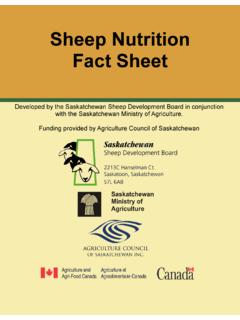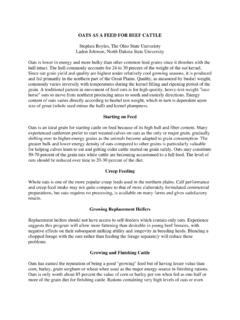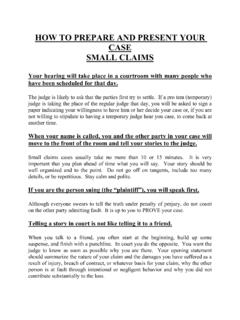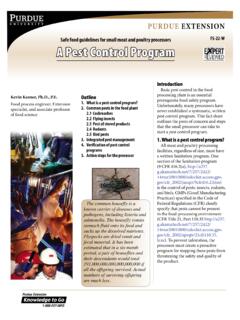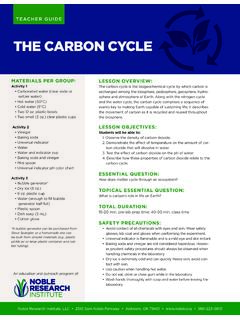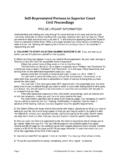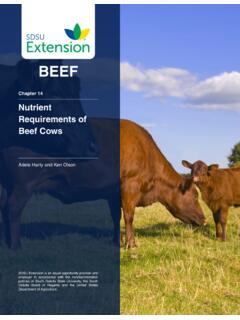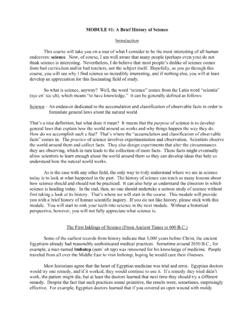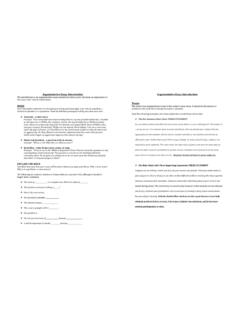Transcription of Sheep Nutrition Fact Sheet
1 Sheep Nutrition fact Sheet Developed by the Saskatchewan Sheep Development Board in conjunction with the Saskatchewan Ministry of Agriculture. Funding provided by Agriculture Council of Saskatchewan Sheep Nutrition Feed vs. Nutrients A balanced feed ration is essential for normal health, growth and reproduction. Nutrients in the feed are utilized by the Sheep to meet their nutritional requirements. It is not the feed itself that meets these needs, but the components that make up the feed. fact Sheet Digestion in Sheep Like cattle, Sheep are ruminants. A ruminant animal has a compartmental stomach which contains the rumen, reticulum, omasum and abomasum. The rumen allows the animal to consume plant material and retain it long enough to allow bacteria, protozoa and fungi to break down and digest the material.
2 The plant material is consumed quickly, regurgitated and re-chewed and then swallowed. This process is called cud-chewing. A healthy mature Sheep will chew their cud for several hours each day. Definitions Protein % Used for muscle and bone development, body maintenance and reproductive processes. Results are expressed as a percentage of the diet. Total Digestible Nutrients (TDN) % An estimate of the energy content in the diet which can be used by the animal. TDN values are expressed as a percentage of the diet. Calcium % Important in bone strength and development, reproduction, milk production and body maintenance. Calcium levels are expressed as a percentage of the diet. Phosphorus % Required in association with calcium for proper bone development, energy processes and reproduction.
3 Expressed as a percentage of the diet. Water Water is the single most important nutrient required by livestock. Sheep require a daily amount of 1 gallon per 100 lbs of bodyweight. One square foot of surface water area must be provided for every 40 head of Sheep . Water can contain dissolved minerals, pollutants, micro-organisms, suspended solids as well as organic and inorganic compounds. Water sources should be tested to determine the quality, as poor water quality will have negative affects on production. Maximum Safe Level (mg/1 or ppm) Total Dissolved Solids (TDS) 5000 - can cause diarrhea and digestive upset Sulfates (S04) <900 - reduces copper availability; associated with thiamine deficiency Nitrates <100 - additive with nitrates in feed; decreases Vit A and E, Iodine and Phosphorus availability Nutrition Body Condition Scoring Body weight and condition scoring can help producers make important feed management decisions throughout the production cycle.
4 Condition scoring is a technique by which the producer can measure the amount of muscle and fat a Sheep is carrying at a certain time. This information can be used to categorize breeding animals relative to body fat and allows decisions to be made for maximum profitability. Body condition scoring should be done at least three times per year. Six weeks prior to breeding, mid pregnancy and in late pregnancy. To condition score the ewe should be felt over and around the backbone, in the loin region, behind the last rib and above the kidneys. This should be done with thumb and fingers. Ewes are scored on a scale of 0 - 5. A score of 0 is a ewe that is completely emaciated, whereas a score of 5 is a ewe that is extremely fat.
5 Ideally, a score of should be achieved when on a maintenance ration and increasing to a prior to breeding. It is important to maintain a body condition score of for the first 30 days following breeding to optimize conception rates. There are four important nutritional periods for the ewe: Flushing and breeding Last four weeks of gestation Lactation Dry period Ewes should be condition scored prior to flushing to determine the effectiveness of flushing. Ewes with a condition score of 4-5 cannot be economically flushed, whereas ewes with a condition score 3-4 respond to flushing. Score 1 Backbone feels very sharp, skeletal features are prominent with no fat cover Muscle is evident, but very shallow Score 2 Spinal processes have a smooth and rounded feel due to depth of muscle tissue Absence of fat cover Animal appears thin but skeletal features are smooth and do not protrude Score 3 Loin muscle is full with moderate fat cover Spinal processes can be felt with pressure Fat can be felt in shoulder, tail head and fore rib areas Still recommended to flush prior to breeding Score 4 Spinal processes are covered with a moderate layer of fat and muscle Overall appearance of the Sheep is smooth.
6 Hipbone is not visible Firm fat deposits are evident in the tail head and brisket This may be acceptable for the show ring but is considered too fat for breeding Score 5 The Sheep are over fat They appear uncomfortable and reluctant to move Vertical process appears indented due to fat build up ** It is important to BCS some of the same ewes to get a realistic comparison each time. Spine prominent and sharpNo fat coverTransverse process sharpFingers easily pass underCondition 1 -EmaciatedSpine prominent and sharpNo fat coverTransverse process sharpFingers easily pass underCondition 1 -EmaciatedSpine prominent and smoothThin fat coverTransverse process roundedFingers go under with pressureCondition 2 -ThinMuscles medium depthSpine prominent and smoothThin fat coverTransverse process roundedFingers go under with pressureCondition 2 -ThinMuscles medium depthSpine detected only as a lineFat cover thickTransverse process cannot be feltCondition 4 -FatMuscles fullSpine detected only as a lineFat cover thickTransverse process cannot be feltCondition 4 -FatMuscles fullSpine rounded and smoothModerate fat coverTransverse process smooth and
7 RoundedFingers need hard pressure to find endsCondition 3 -AverageMuscles fullSpine rounded and smoothModerate fat coverTransverse process smooth and roundedFingers need hard pressure to find endsCondition 3 -AverageMuscles fullSpine not detectable; fat dimple over spineFat cover very thickTransverse process not detectableCondition 5 -ObeseMuscles very fullSpine not detectable; fat dimple over spineFat cover very thickTransverse process not detectableCondition 5 -ObeseMuscles very fullGraphics from the University of Kentucky College of Agriculture, Department of Animal Sciences Nutrition Requirements through the Production Cycle Nutrient requirements vary during the production cycle as there are different demands put on the body. Ewes, rams, lambs and replacement ewe-lambs all have varying nutritional needs.
8 It is important to know the production phases and what is required for each stage nutritionally. Production phases: Ewes - Maintenance, Early and Late gestation, Lactation and Breeding Replacement Ewe-Lambs - Growth, Pre-breeding, and Post breeding Lambs - Pre-weaning, Post weaning, and Finishing Rams - Maintenance, Pre-breeding, Breeding Maintenance Production phase with lowest nutrient requirements. Can use lowest quality feeds including pasture or poor quality crop residue. Still require salt and minerals. Pre-Breeding/Flushing Ewes Increasing dietary energy prior to breeding. Usually done by increasing the level of grain in the ration 30 days prior to ram turnout. Continue about 3 weeks after ram turnout. Minerals are important.
9 Late Gestation The last 40-45 days before lambing. There is major fetal development during this time and energy requirements increase substantially. A higher energy diet is required. Overfeeding at this time can cause dystocia. Lactation This phase requires a very high level of energy. Milk production peaks at 2-3 weeks after lambing and declines to a low by 8-10 weeks. Mineral supplementation is important. Maint. Breeding Late Preg. Lactation Protein 10-12 13-14 Energy TDN 55 59 60-65 65 Calcium Phos-phorus Suggested Nutrient Level in Diet (%) (Based on 100% dry matter ) Ewe Maintenance - Flushing - 1st 15 Weeks of Gestation - Last 4 Weeks of Gestation 130-150% lamb crop - Last 4 Weeks of Gestation 180-220% lamb crop - Lactation - Suggested Dry matter Intake (% of body weight) Feed Protein TDN % Calcium Phosphorus Alfalfa 16% 55.
10 19% Grass Hay 50 .50% .16% Oat Green feed 55 .32% .20% Barley Straw 45 .40% .09% Lentil Straw 46 .65% .20% Flax Straw .30% .20% Barley Silage 12% 59 .46% .30% Vetch Hay 18% 58 .34% Analysis of Feed Used - Forages Feed Protein TDN % Calcium Phosphorus Barley 83 .06% .36% Oats 77 .06% .33% Peas 29% 87 .11% .44% Canola Meal 30% 76 .72% Lentil Screenings 21% 77 .11% .44% Screening Pellets 13 - 16 72 - 78 .14% .32% Limestone 38% Analysis of Feed Used - Grains, Byproducts and Supplements Dry matter Basis Dry matter Basis Nutrition handfuls of this ration in a feeding area available only to the lambs. Keep the feed fresh. A suggested creep and pre-grower ration is 18% protein and 90% Dry matter basis. Things to Keep in Mind Energy Energy is the most limiting nutrient, and therefore the most important nutrient in Sheep rations.
